Improving Gender Balance in NIME Research
This blog post is the web page companion of the paper “Who Are the Women Authors in NIME? - Improving Gender Balance in NIME Research” (Xambó 2018). This paper looks at the underrepresentation of women at the New Interfaces for Musical Expression (NIME) conference and how we can improve the representation of women at NIME. In particular, it focuses on what has been the level of representation of women authors in NIME over the course of the years from 2001 to 2017 and whether there has been any improvement. This blog post highlights the descriptive statistics results to give some context to the directory of WiNIME. The reader is welcomed to explore the full paper to get a deeper sense of the current numbers and potential solutions. The selected bibliography used in this paper is also available online.
The data source comes from the online proceedings of the NIME conference, which are publicly available on GitHub. The data was sanitized (e.g., errors, redundancies) and a manual identification of gender was conducted. The limitations of this approach are that only authors from the proceedings are included (potentially losing performance artists who do not publish in the proceedings, see Morreale et al. 2018 to know more about their profile); geographical and institutional information; and the use of a gender binary approach as a starting point. We analyzed 1,562 documents and 2,110 authors in total, out of which we identified 291 women authors and 1,819 men authors.
Percentage of Unique Women Authors (2001-2017)
The percentage of unique women authors, from 2001 to 2017, represented 14% of the total. Although there seems to be a cyclic pattern (Figure 1), there does not seem to be an improvement over the course of the years.
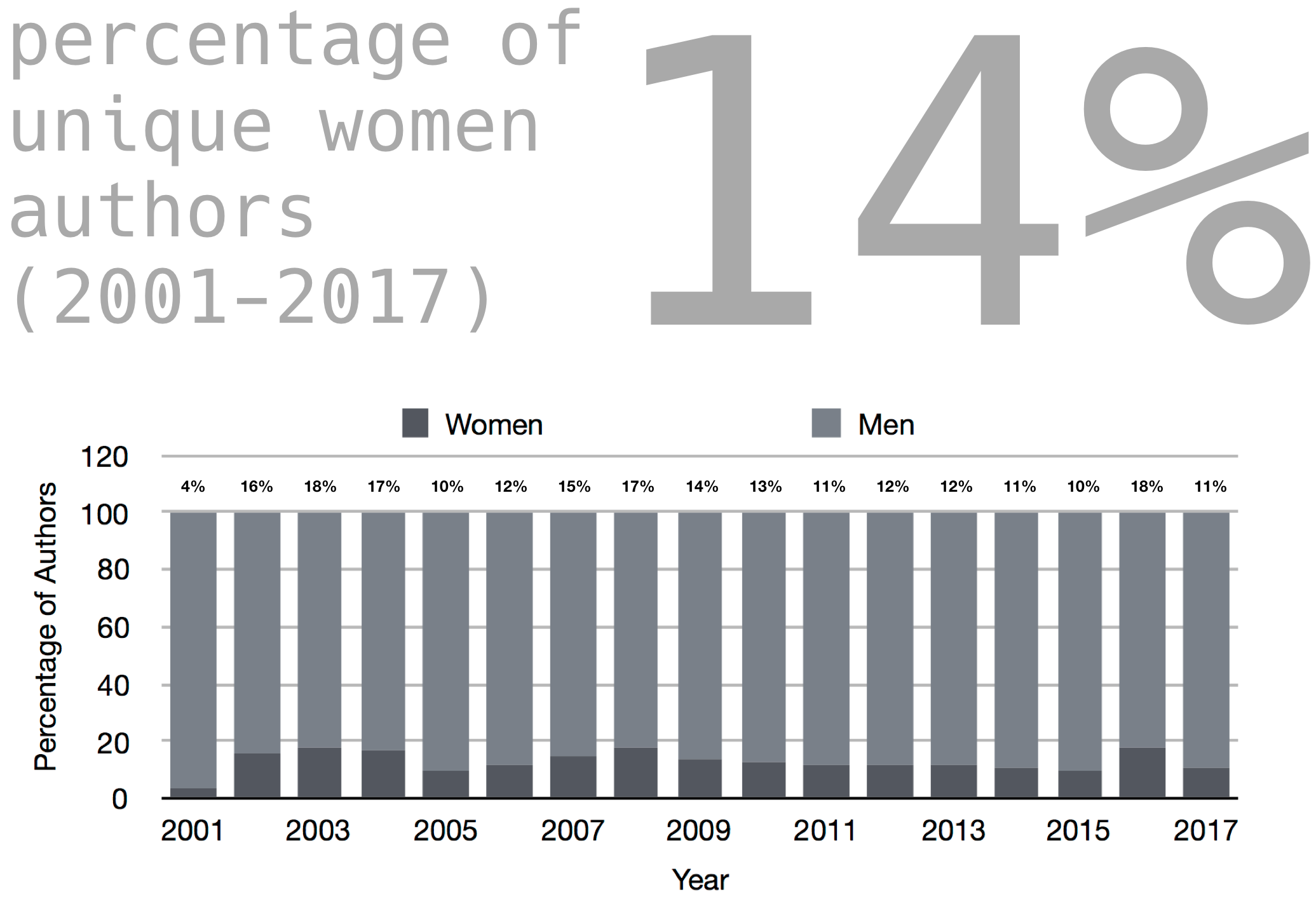
We compare this average percentage with the average percentages of other related communities. The goal is to get a sense of the level of similarity with its neighbor conferences, acknowledging that these other percentages have been calculated using different methods and the range of years varies. It is noteworthy that the result is consistent with similar communities, such as the International Computer Music Association (ICMA), with reported ranges between 14.5% and 19.6%, and the International Society of Music Information Retrieval (ISMIR), with a reported average percentage of 14.7%. The International Conference on Auditory Displays (ICAD) reports a better result of 17.9%, whilst Sound and Music Computing (SMC), the International Computer Music Conference (ICMC), and the Audio Engineering Society (AES) report 12.2%, 8.8%, and less than 10%, respectively.
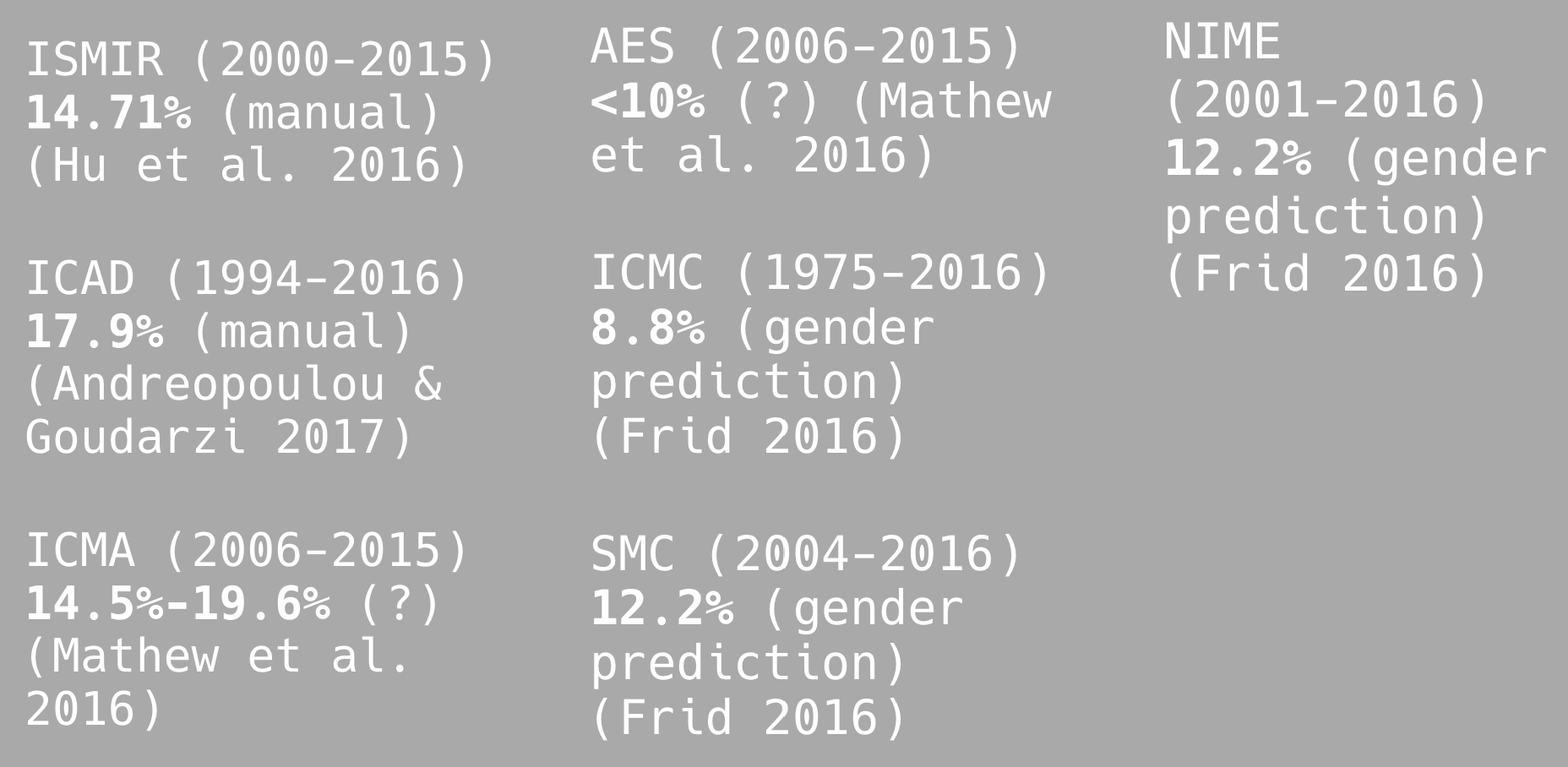
Given that NIME started as a spin-off workshop from the Computer-Human Interaction (CHI) conference, we compare these results with human-computer interaction (HCI) conferences. In particular, if we look at CHI, we realize that there is a reported improvement from 10% to 20% of women authors over the course of 26 years. Even more presence of women authors and improvement over the course of the years is found in the Scandinavian conference NORDCHI, moving from 20% to 30% within 6 years. This indicates that an improvement is possible, and lessons need to be learned from these successful examples.

Percentage of Publications by Gender (2001-2017)
Figure 4 shows the percentage of papers with at least one woman author involved (M=24.4%, SD=6.6%) vs papers written by only men. Similarly, Figure 5 shows the percentage of papers with women first-authors (M =11.9%, SD=5%) vs men first-authors. The percentage shows that the around half of the papers that involve women had women as the first author, which means that for the other half of papers with women involved, the women authors collaborated in the papers without necessarily leading them. Having women first authors is important to promote role models and also to let women have a voice.
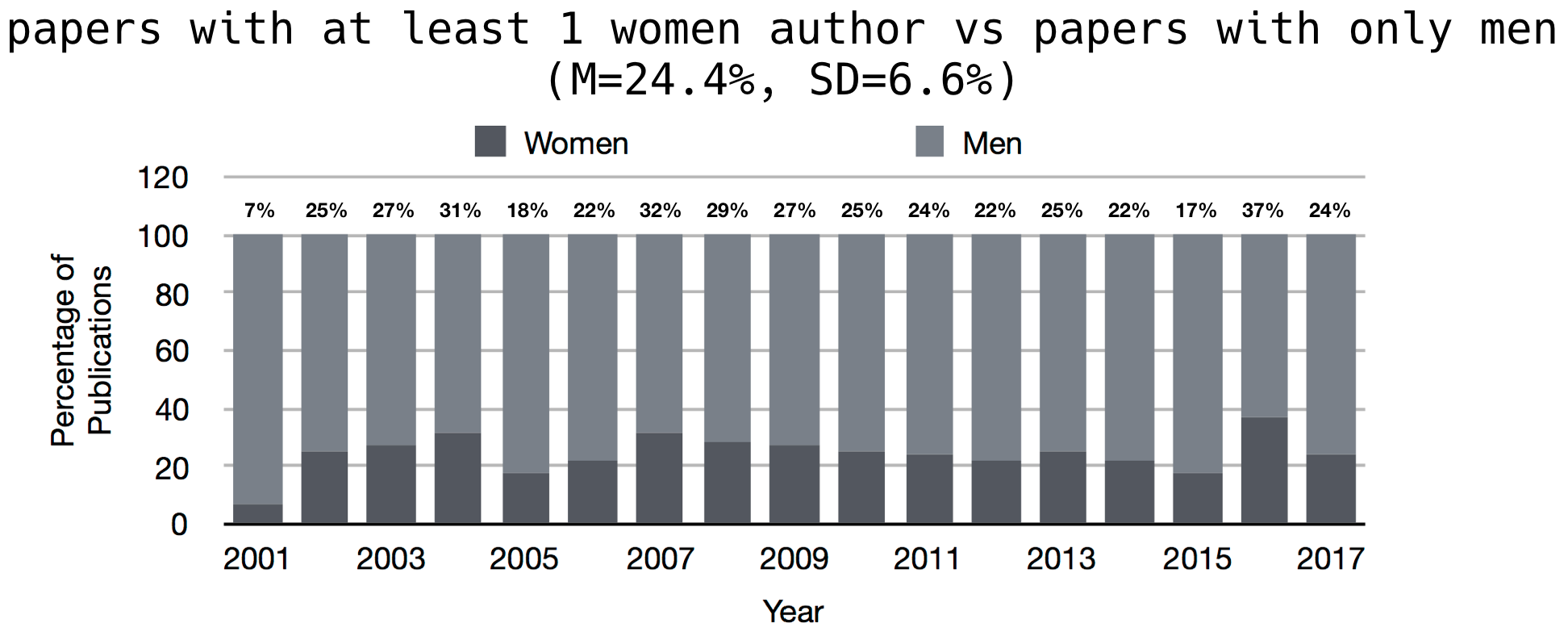
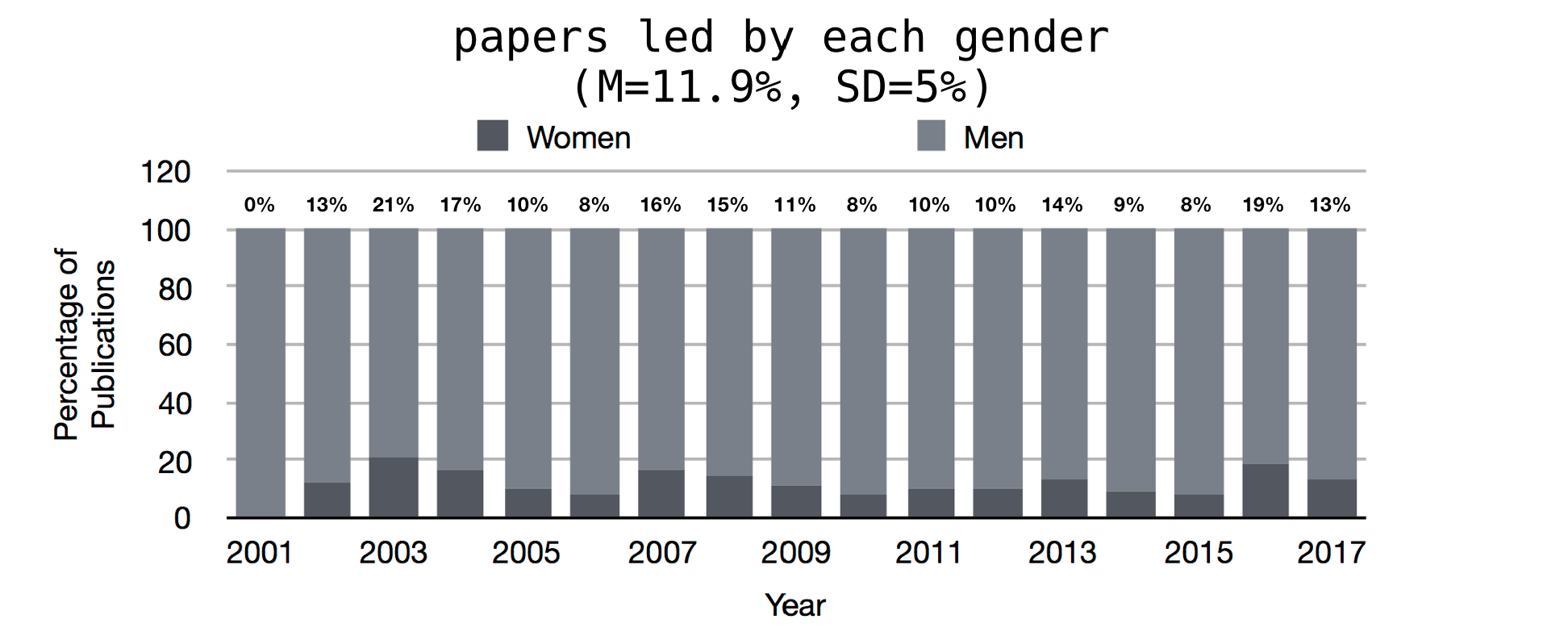
Frequency of Papers by Author (2001-2017)
Figure 6 illustrates the frequency of papers published by authors, showing an exponential shape from many authors just publishing one paper (215 of a total of 291 women; 1,277 of a total of 1,819 men), and fewer authors publishing two papers (41 women; 263 men) or three papers (20 women; 103 men). Figure 7 shows a closer look at the frequency of papers published by women. Two women and three men authors have published 16 papers each, which implies almost one per year. Beyond this threshold value, only 11 men authors have published a larger amount from 17 (2 authors) up to 42 papers (1 author). These results indicate the nature of the NIME conference as a one-shot conference for many authors. It also indicates that the productivity of men authors is higher than women authors, which contrasts with reported results in ISMIR of similar productivity results between both genders (see Hu et al. 2016). From these results, some questions emerge, such as how can we incentivize women authors to come to the NIME conference and whether the conference is interested in attracting authors to publish more than once.
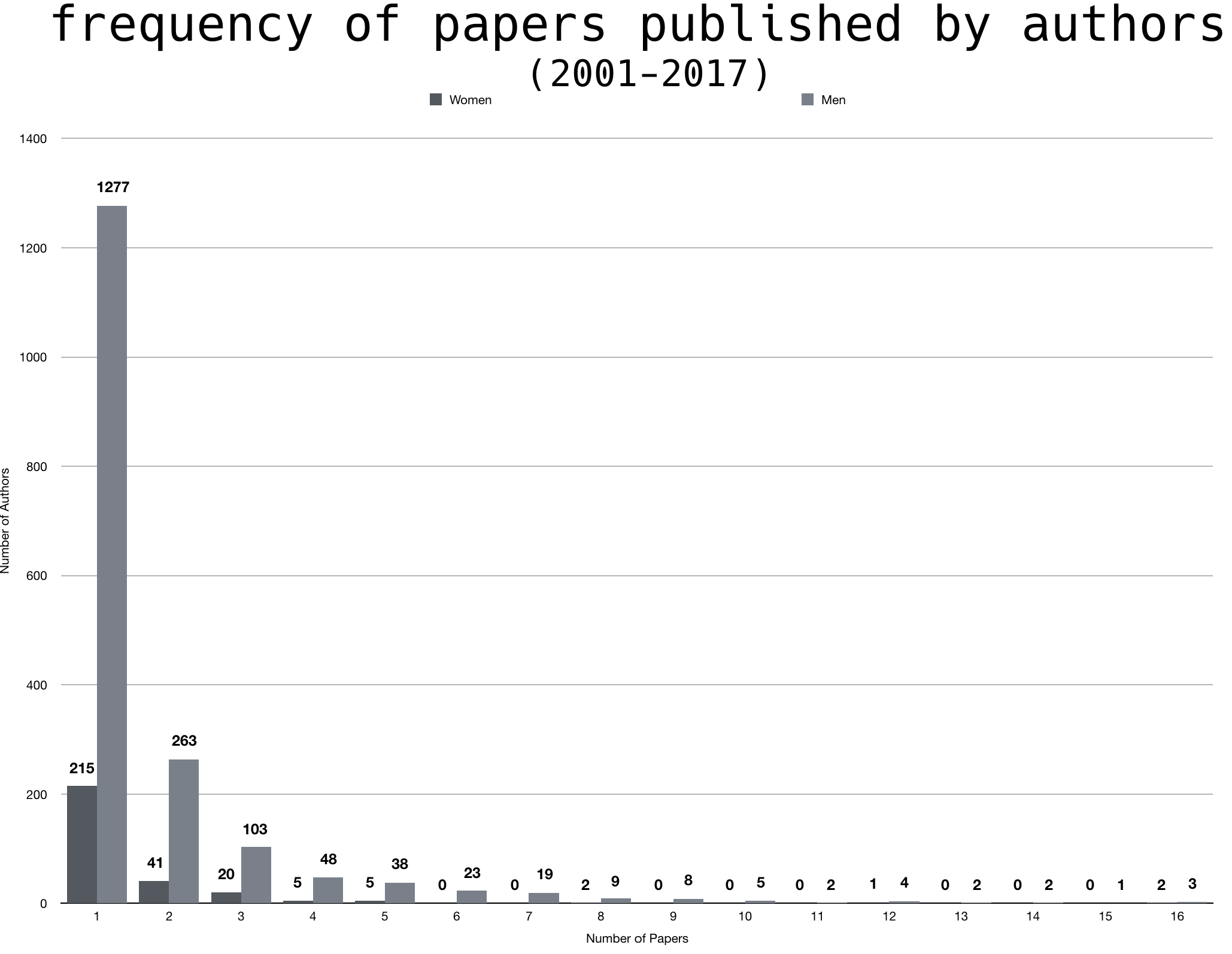

Take-away Message
In the paper related to this blog post, we discuss successful organizations of women related to sound and music computing, particularly looking at the Women in Music Tech (WiMT) organization from Georgia Tech, and we also present the directory of WiNIME, which aims to make more visible NIME women authors’s work. The oral presentation of this paper at NIME 2018 and the take-away message that we can be agents of change and that this is an all-group problem was extremely well-received. With still much work to do, this NIME’s edition has put visible efforts to bring more diversity into the fore and raised the bar for the forthcoming editions. During the closing, the NIME committee presented already a set of future actions to improve the current situation. Looking forward to next year’s NIME edition at Porto Alegre in Brazil!
References
- A. Andreopoulou and V. Goudarzi. Reflections on the Representation of Women in The International Conferences on Auditory Displays (ICAD). In Proceedings of the 23rd International Conference on Auditory Display, pages 43–48, 2017.
- E. Frid. Sonification of Women in Sound and Music Computing-The Sound of Female Authorship in ICMC, SMC and NIME Proceedings. In Proceedings of the International Computer Music Conference, 2017.
- X. Hu, K. Choi, J. H. Lee, A. Laplante, Y. Hao, S. J. Cunningham, and J. S. Downie. WiMIR: An Informetric Study On Women Authors In ISMIR. In Proceedings of the 17th International Society for Music Information Retrieval Conference, pages 765–771, 2016.
- J. J. Kaye. Some Statistical Analyses of CHI. In CHI’09 Extended Abstracts on Human Factors in Computing Systems, pages 2585-2594, 2016.
- M. Mathew, J. Grossman, and A. Andreopoulou. Women in Audio: Contributions and Challenges in Music Technology and Production. In 141st Audio Engineering Society Convention, pages 1–10, 2016.
- F. Morreale, A. P. McPherson, and M. M. Wanderley, Identity from the Performer’s Perspective. In Proceedings of the New Interfaces for Musical Expression, pages 168-173, 2018.